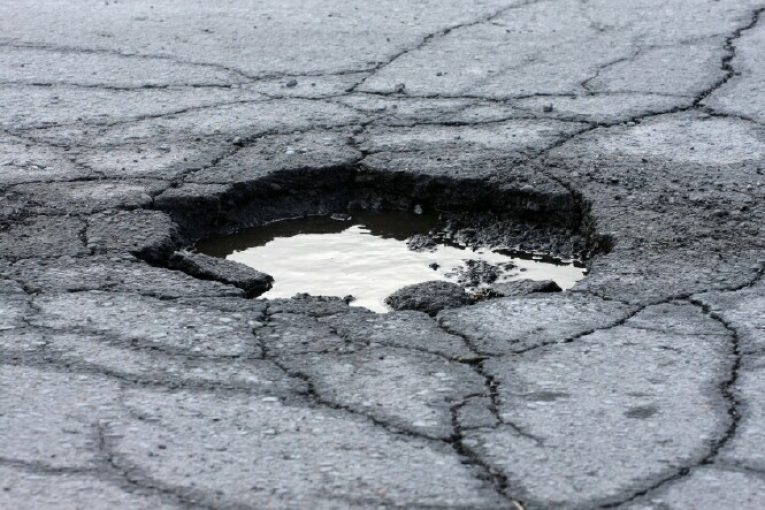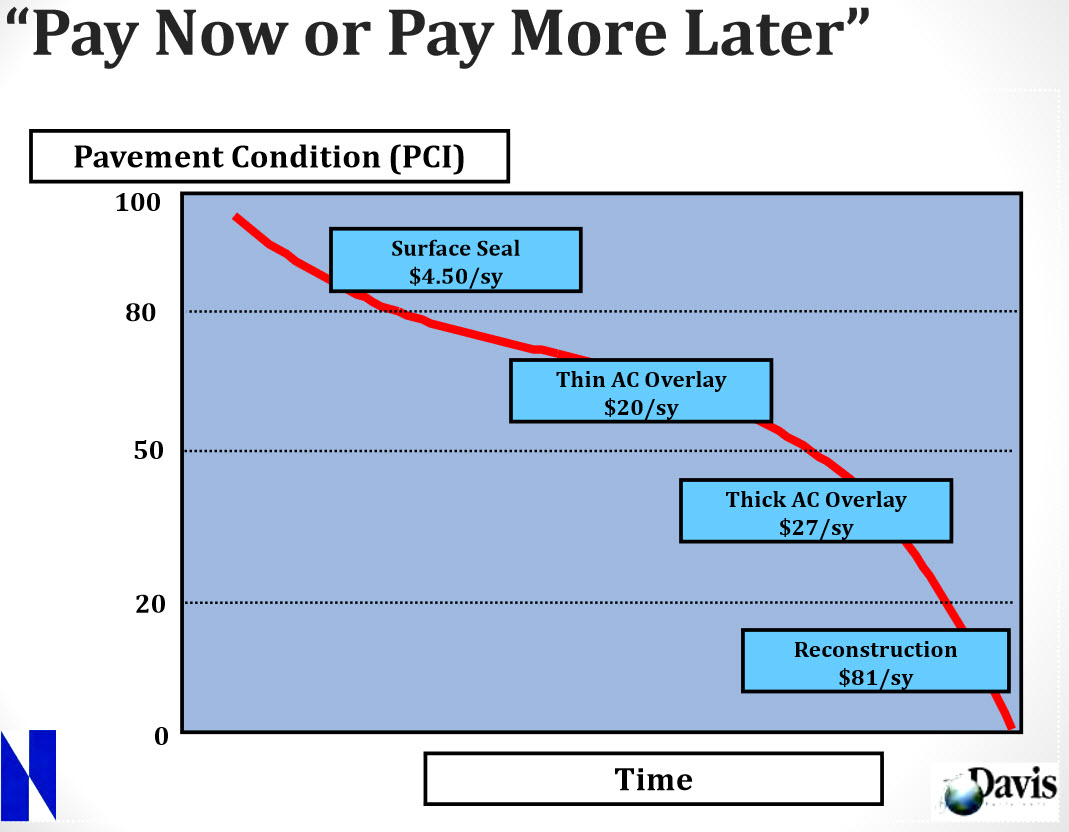
Dan Carson back in June argued that the city needed to take a slower track for a second tax vote in part because of the assumption that asphalt road costs will grow 8 percent a year. Mr. Carson two weeks ago presented his new road rehabilitation cost projections and he argues that the “inflation assumptions contained in the Nichols report significantly overstate the costs the city would incur in the future to fix its streets and bike paths.”
Dan Carson writes, “This is partly due to some technical problems with the original computations but mainly because economic trends have changed greatly in the nearly two years since the Nichols report was released. An index based on crude oil prices that the Nichols report relied upon heavily to project asphalt paving costs has declined dramatically since January 2013, the beginning of Nichols’ projection period, rather than escalating rapidly as Nichols had forecast.”
Updating the cost projection model that Nichols used, Mr. Carson finds that “the original Nichols report overestimated what it had identified as the ‘budget needs’ for the road and bike path work by as much as a third.”
He argues, “Rather than facing a $154 million bill to do the needed work, the “budget needs’ may be as low as $103 million, or more than $50 million less than estimated by Nichols.”
He also believes that “the amount of city revenues likely to be available during that 20-year period to pay for such projects could be $96 million or more – fairly close to the estimate of ‘budget needs.’”
At the same time, he warns, “The city does not have the financial resources in place to catch up immediately on the existing backlog of work, or to prevent any future backlogs from occurring, the true cost of the work is certain to exceed even my lower ‘budget needs’ estimate. Costs will go up as projects are delayed for lack of funding.”
The bottom line, according to Mr. Carson, is that “my analysis indicates that the Nichols report estimates of how costs would escalate because of constraints on available funding are, like their estimate of ‘budget needs,’ significantly overstated. The adoption of more reasonable inflation assumptions, such as those I examined, means that the city’s pavement rehabilitation problems are more manageable than presented previously and that the city has more options than it previously understood for addressing these very real costs for ensuring mobility for Davis citizens.”
City staffers are reportedly examining Mr. Carson’s analysis. Last week, the Vanguard met with Mr. Carson and the bottom line from his perspective was that the job of the Finance and Budget Commission and his work was to create a realistic baseline from which to assess how to handle policy priorities.
From the Vanguard’s perspective, we are not going to dispute the revised numbers at this time. It is clear that oil prices have fallen much further and faster than anyone anticipated in the spring of 2013. We remain concerned, however, that even a revised pavement cost projection of $100 million is a substantial hit to the city.
Moreover, we have not yet seen numbers of the costs of parks, buildings and other infrastructure needs that the city is facing. We are concerned that momentum has seemed to stall on a parcel tax that would become the funding mechanism for these infrastructure repairs.
The city’s policy has been described as B-modified, which would frontload about $25 million in funding for immediate road work with about $3 million per year in ongoing costs. Even in that scenario, the city concluded that this would not be enough to maintain a good average PCI (Pavement Condition Index).
Reduced costs, therefore, would not remove the city from the need to fund roads and bike paths, but might make it possible to actually improve road conditions up to a PCI of 70 rather than the projected 60 to 63 that the current plan concedes.
One of the huge inflators is not only the ongoing inflation but also the exponential increase in pavement repairs as conditions worsen.
As the chart shows, it’s relatively inexpensive to patch the surface. However, the cost quickly rises five-fold to pay for the $20 per square yard cards of a thin AC Overlay; it goes up another 35% to do a thick AC Overlay; and, for the streets that are almost gone, $81 per square yard.
In the last three years, we have been somewhat fortunate that we have not had a lot of rain – at least on the pavement front. Bob Clarke back in June warned that pavement conditions were on the edge and could quickly deteriorate. This year, with a renewal of heavy storms, we could see a heavy toll on roadways where foundations are already cracked, allowing water to get into the roadbed and create massive pots holes and other problems.
How will this impact cost? We know that costs go up by a lot as conditions deteriorate.
Bottom line, from our perspective, is if the estimates suggested in the Nichols report were overstated, the number that Mr. Carson arrives at, $100 million rather than $150 million, remains daunting. Roads and bike paths are not our only critical need in infrastructure either and the costs that Mr. Carson estimates, he acknowledges will increase if the funding is not available.
We appreciate Mr. Carson’s desire to create an accurate baseline and starting place for analysis, but at the end of the day, we do not see the bottom line changing. The city council projected that we needed $25 million to start plus $3 million in ongoing funding, and we don’t see the need to change.
We would like to see a full discussion by council on our current infrastructure needs with estimated costs as precise as possible. Based on that, the council can make an informed decision as to how much we need, what we need to spend it on, and how much we need to ask for from the voters for how long.
To read Mr. Carson’s full report click here.
—David M. Greenwald reporting







We are now well past the “could see” portion of the program. The promised water-induced road destruction is upon us. The deep, sharp holes are all over town now. And I can speak directly to their property damage potential. I hit one on Cowell at under 30 mph (in the rain when it was full and invisible), and it destroyed my tire. $400 and several hours later, I was good to go.
This is not an indication that the cost was over-estimated. It is an indication that we have zero control over what this expense will be. Claiming that repairing the roads will now forever be cheaper because the price of oil has dropped recently is a recipe for disaster. We have no idea what the cost of oil will be when we finally get around to the repairs (gosh… are we taking advantage of these lower oil prices to get the work done now at a $50 million savings??)
These pot holes are an expensive inconvenience for motorists. At the same time, they can be deadly for cyclists.
well said. dan carson has been trying to downplay the fiscal impact of things for some time – not exactly sure why that’s the case. $100 million or $150 million indicates imprecision of models and assumptions. what remains indisputed is that we are in the rears.
Well said darrelldd and Davis Progressive. As the Vanguard points out, there are maintenance and repairs to buildings and pools that also need to be addressed, as well as roads. The city isn’t even close to being out of the fiscal woods.
What do you drive that has $400 tires (I paid less than that for two of my tires)?
The destruction of one tire required the replacement of two tires to keep the differential from having to work while driving in a straight line. Total cost for two tires and labor from our local Goodyear dealer was $408. What I drive is an 2002 Toyota Rav4EV (Production Electric Vehicle), and the tires are purpose-made for this vehicle. I don’t have any choice to shop around for competitive pricing. There are plenty of cars plying our roads with tires that cost $600 each.
Darel wrote
> Total cost for two tires and labor from our
> local Goodyear dealer was $408.
thanks for the clarification when you said you damaged one tire $400 was more than a friend pays for each tire on his Ferrari.
P.S. Can you name a few of the “plenty” of cars you see in town that have tires that cost $600 EACH?
I too am concerned about silence on the parcel tax, but I assume the City Council will have this item on its agenda at the beginning of the year.
yes, but that probably means either a rush job to get it on the ballot or we wait until 2016. neither is ideal. we had plenty of time to deal with this – and there has been absolutely no outreach by the council on this.